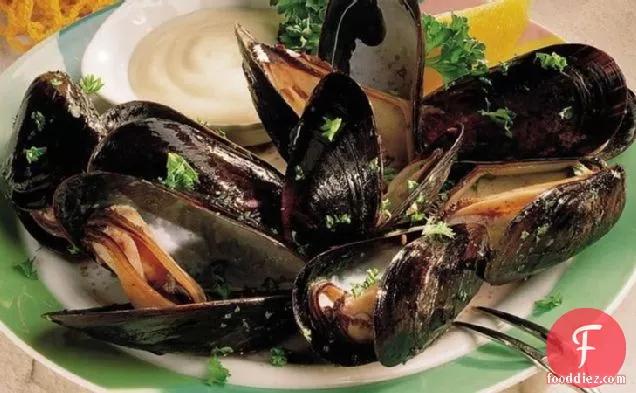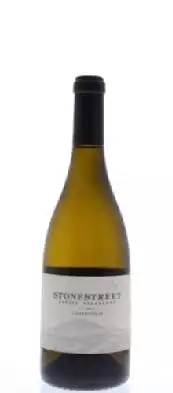Mussels with Mustard Sauce

Mussels with Mustard Sauce is a gluten free recipe with 4 servings. This recipe covers 24% of your daily requirements of vitamins and minerals. This hor d'oeuvre has 145 calories, 16g of protein, and 4g of fat per serving. A mixture of honey, cream, garlic, and a handful of other ingredients are all it takes to make this recipe so yummy. To use up the low fat sour cream you could follow this main course with the Angel Food Cake as a dessert.
Instructions
1
To clean mussels, discard any broken-shell or open (dead) mussels. Scrub remaining mussels in cold water, removing any barnicles with a dull paring knife. Pull beard by giving it a tug (using a kitchen towel may help). If you have trouble removing it, use a pliers to grip and pull gently.
Ingredients you will need![Mussels]() Mussels
Mussels![Water]() Water
Water
Equipment you will use![Kitchen Towels]() Kitchen Towels
Kitchen Towels![Knife]() Knife
Knife
2
Place mussels in large container. Cover with cool water. Agitate water with hand, then drain and discard water. Repeat several times until water runs clear; drain.
Ingredients you will need![Mussels]() Mussels
Mussels![Water]() Water
Water
3
In 4-quart nonstick Dutch oven, heat oil over medium heat. Cook garlic and pepper in oil, stirring frequently, until garlic is softened. Stir in wine; heat to boiling. Stir in mussels and parsley. Cover and heat to boiling; reduce heat. Simmer 5 to 10 minutes or until mussel shells have opened. Stir to coat with liquid. Discard any mussels that do not open.
Ingredients you will need![Mussels]() Mussels
Mussels![Parsley]() Parsley
Parsley![Garlic]() Garlic
Garlic![Pepper]() Pepper
Pepper![Pasta Shells]() Pasta Shells
Pasta Shells![Wine]() Wine
Wine![Cooking Oil]() Cooking Oil
Cooking Oil
Equipment you will use![Dutch Oven]() Dutch Oven
Dutch Oven
Ingredients
118milliliters![dry red wine or Progresso® chicken broth (from 32-oz carton)]() dry red wine or Progresso® chicken broth (from 32-oz carton)2Tbsps
dry red wine or Progresso® chicken broth (from 32-oz carton)2Tbsps![Dijon mustard]() Dijon mustard118milliliters
Dijon mustard118milliliters![Yoplait® Fat Free plain yogurt (from 2-lb container)]() Yoplait® Fat Free plain yogurt (from 2-lb container)59milliliters
Yoplait® Fat Free plain yogurt (from 2-lb container)59milliliters![chopped fresh parsley]() chopped fresh parsley2cloves
chopped fresh parsley2cloves![garlic, finely chopped]() garlic, finely chopped1teaspoon
garlic, finely chopped1teaspoon![honey]() honey1Tbsp
honey1Tbsp![reduced-fat sour cream]() reduced-fat sour cream907grams
reduced-fat sour cream907grams![fresh mussels]() fresh mussels1teaspoons
fresh mussels1teaspoons![cracked black pepper]() cracked black pepper1teaspoon
cracked black pepper1teaspoon![olive or vegetable oil]() olive or vegetable oil
olive or vegetable oil
 dry red wine or Progresso® chicken broth (from 32-oz carton)2Tbsps
dry red wine or Progresso® chicken broth (from 32-oz carton)2Tbsps Dijon mustard118milliliters
Dijon mustard118milliliters Yoplait® Fat Free plain yogurt (from 2-lb container)59milliliters
Yoplait® Fat Free plain yogurt (from 2-lb container)59milliliters chopped fresh parsley2cloves
chopped fresh parsley2cloves garlic, finely chopped1teaspoon
garlic, finely chopped1teaspoon honey1Tbsp
honey1Tbsp reduced-fat sour cream907grams
reduced-fat sour cream907grams fresh mussels1teaspoons
fresh mussels1teaspoons cracked black pepper1teaspoon
cracked black pepper1teaspoon olive or vegetable oil
olive or vegetable oilRecommended wine: Chardonnay, Muscadet, Riesling
Shellfish on the menu? Try pairing with Chardonnay, Muscadet, and Riesling. Buttery chardonnay is great for scallops, shrimp, crab, and lobster, while muscadet is a classic pick for mussels, oysters, and clams. If you've got some spice in your shellfish, a semi-dry riesling can balance out the heat. The Stonestreet Estate Chardonnay with a 4.1 out of 5 star rating seems like a good match. It costs about 36 dollars per bottle.

Stonestreet Estate Chardonnay
The 2012 Estate Chardonnay delivers a distinct mineral backbone alongside a strong citrus element. Tangerine and marmalade emerge first from the glass, opening to a palate that cascades through peach and ocean spray—all culminating in a finish with surprising grip and acidity.DifficultyMedium
Ready In40 m.
Servings4
Health Score74
DietsGluten Free
Related recipes
Turkey with Country Ham Stuffing
Party Italian Wedding Soup
Turkey Alfredo Tetrazzini
Stuffed Shells with Meat Sauce
Magazine

Your Inner Chef with Taylor Swift's Top 3 Recipes from Her Beloved NYC Hangout

20 Mouthwatering Recipes You Need to Try Today!

Master the Art of Making Perfect Pancakes with This Foolproof Recipe

The Science Behind Red Wine: Its Surprising Health Benefits and Potential Risks

12 Wine Cocktails for a Sophisticated Twist

Sip, Swirl, and Celebrate: Toasting to National Wine Day on May 25th

National Drink Wine Day on February 18

Celebrating Souffle Day with Delectable Delights

Indulge in the Delightful Flavor of Oyster Soup on Its Special Day!

Celebrating World Nutella Day

13 Seductive Chocolate Recipes You Need to Try Now

21 Date Night Recipes to Make Together

22 Best Bread Recipes

24 Comforting Soul Food Recipes

25 Easy Midweek Meals

November Foods in Season and What to Cook With Them

Traditional Chinese Foods

Traditional Eastern European Foods

Traditional European foods

Traditional Indian foods

Your Inner Chef with Taylor Swift's Top 3 Recipes from Her Beloved NYC Hangout

20 Mouthwatering Recipes You Need to Try Today!

Sip, Swirl, and Celebrate: Toasting to National Wine Day on May 25th

National Drink Wine Day on February 18

Indulge in the Delightful Flavor of Oyster Soup on Its Special Day!

These Super Recipes for Your Football Party!

The Secrets Behind 3 Classic Comfort Food Recipes

Recipes to Spice Up Your February Menu

Top 20+ Must-Try Recipes Dominating February 2024




